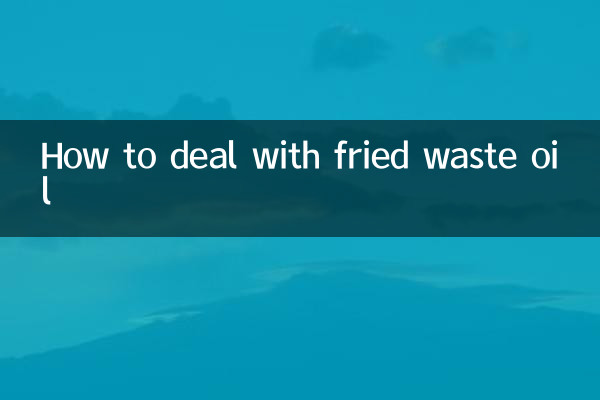How to deal with fried waste oil: analysis of hot spots across the Internet on environmental protection and resource reuse
Recently, with the improvement of environmental awareness and the popularization of garbage classification, "how to deal with fried waste oil" has become a hot topic on the Internet. This article compiles hot discussion data in the past 10 days, ranging from environmental protection policies, scientific processing methods to innovative reuse cases, to provide you with structured solutions.
1. Analysis of popularity data of the entire network (last 10 days)

| platform | Amount of related topics | Highest number of reads | Keywords TOP3 |
|---|---|---|---|
| 12,000 items | 58 million | #gutteroilsupervision#, #biodiesel#, #foodwasteprocessing# | |
| Tik Tok | 8600+ videos | 42 million likes | Waste oil soap, recycling channels, environmental protection tips |
| Zhihu | 370+ questions and answers | 920,000 collections | Principles of chemical reactions, municipal recycling, EU standards |
| Station B | 210+ popular science videos | 1.5 million views | DIY tutorials, microbial degradation, carbon neutrality |
2. Comparison of mainstream processing methods
| Processing method | Applicable scenarios | advantage | shortcoming |
|---|---|---|---|
| Professional organization recycling | Catering enterprise/community concentration point | Convert to biodiesel | Few individual user channels |
| homemade soap | Small amount of household waste oil | Economical and environmentally friendly | Requires sodium hydroxide and risks |
| Garbage classification and placement | There is a dedicated recycling bin area | The government handles it uniformly | Some areas are not covered |
| microbial degradation | experimental treatment | No secondary pollution | High cost and high technical threshold |
3. Latest policy developments
According to the new regulations of the Ministry of Ecology and Environment in June:Before the end of 2023, prefecture-level cities across the country need to build at least one food waste treatment center, and catering companies are clearly required to sign an agreement with a qualified waste oil recycling unit. Individual users can check the nearest recycling point through the "City Service" WeChat applet.
4. Cases of innovation and reuse
1.A company in ShanghaiConvert waste oil into aviation fuel, reducing carbon emissions by 75%
2.Chengdu communityCarry out the "waste oil for green plants" activity, with a single recycling amount of 200kg
3.Japanese technologyConvert waste oil into laundry detergent raw materials in 3 hours with a purity of 99%
5. Safety Guidelines for Home Disposal
| step | Things to note | tool |
|---|---|---|
| 1. Cool and let stand | The temperature drops below 60℃ | Heat-resistant container |
| 2. Filter the residue | Use coffee filter/gauze | funnel device |
| 3. Sealed storage | Avoid direct sunlight | Glass/PE material bottle |
| 4. Regular processing | Single storage ≤2 weeks | Tag with date |
6. Expert advice
Professor Li from the School of Environment, Tsinghua University pointed out: "1 ton of waste oilDirect discharge can pollute 50,000 tons of water bodies, but recycling through formal channels can produce 0.9 tons of biodiesel. It is recommended to establishPersonal environmental pointssystem to realize the waste oil recycling traceability reward mechanism through the mobile APP. "
7. Future trends
1.Intelligent recycling equipment: Pilot community recycling bins with weighing and code scanning functions have been added
2.Blockchain application: Ensure the full traceability of the recycling chain
3.Carbon trading link: The amount of waste oil recovered can be converted into carbon emission reduction indicators
The correct disposal of fried waste oil is not only related to environmental protection, but also an important part of resource recycling. It is recommended that users choose the appropriate treatment method according to the actual situation and jointly promote the popularization of green lifestyle.

check the details

check the details